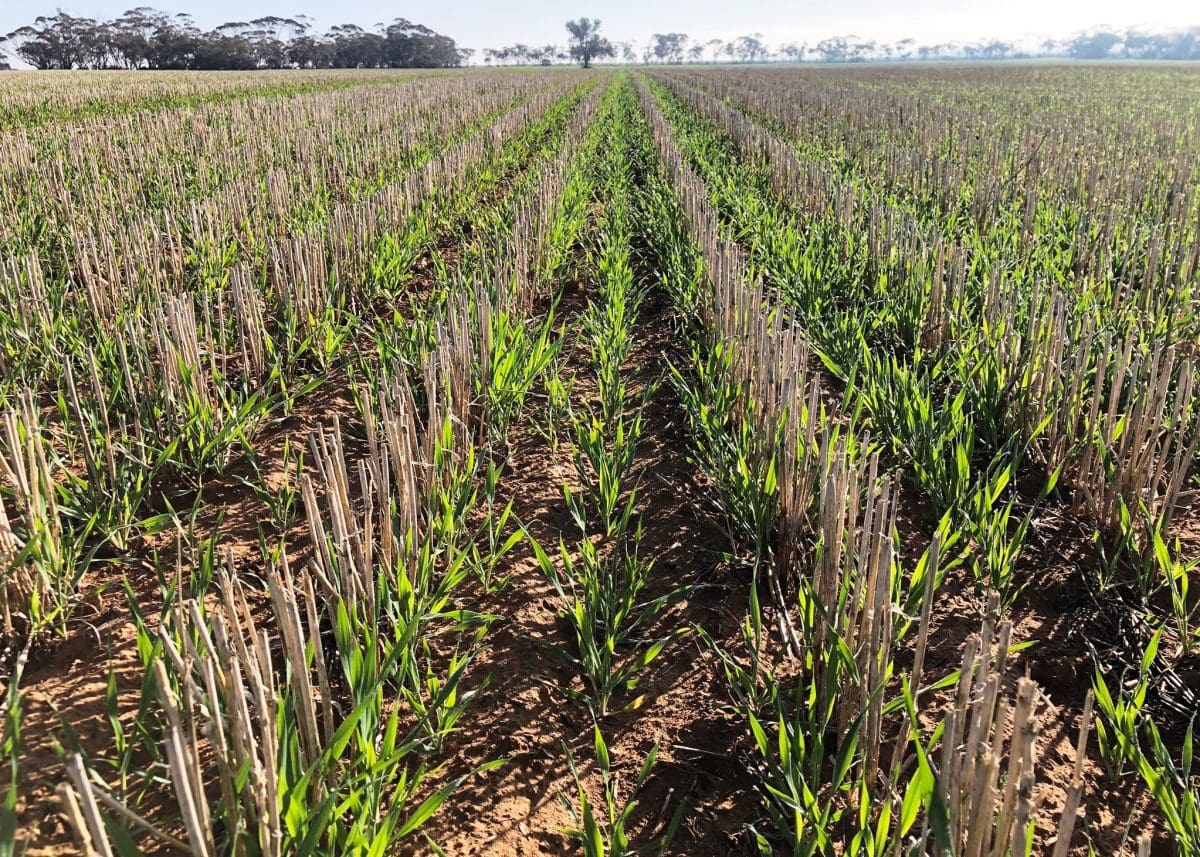
A crop of barley growing near the NSW-Victorian border. Photo: Matt Witney, Dodgshun Medlin
AUSTRALIAN feedgrain values have lost a few dollars this week, with limited sell-side pressure in nearby and new-crop slots tempering the impact of a stronger Australian dollar.
Relaxing COVID-19 restrictions in eastern states are yet to have any impact on congested domestic supply chains, and brokers and traders report that feedgrain demand is negligible.
On new-crop, expected competition from feedlotters and accumulation for a potentially large wheat-export program out of Newcastle appear to have put a floor in bids in northern New South Wales.
In the southern markets, new-crop Australian wheat and barley is looking competitive against Black Sea grain, which is supporting bids that are having trouble inspiring growers to advance forward selling.
| This week | Last week | Change | |
| Barley Downs July | $325 | $330 | Down |
| Barley Downs Jan | $260-$265 | $272 | Down |
| Barley Melbourne nearby | $250 | $255-$260 | Down |
| Barley Melbourne Jan | $240 | $240-$245 | Down |
| Wheat Downs July | $384 | $400 | Down |
| Wheat Downs Jan | $300-$305 | $295 | Up |
| Wheat Melbourne nearby | $355 | $355 | Steady |
| Wheat Melbourne Jan | $298-$300 | $295 | Up |
| Sorghum Downs July | $335 | $355 | Down |
| Sorghum Downs Mar-Apr | $275 | $280 | Down |
Table 1: Indicative delivered grain prices in AUD per tonne.
Mixed conditions
ABARES released its initial estimates for Australian new-crop production, pegging wheat at 26.7 million tonnes (Mt) and barley at 10.6Mt.
Both numbers are in line with industry expectations, and reflect above-average yield prospects for New South Wales, South Australia and Victoria, and average ones for Queensland and Western Australia, where crops missed on the strong early start.
Some crops in the far north of NSW are in need of a drink to preserve above-average yield prospects, and some Darling Downs and southern central Queenland growers who missed out on rain to plant wheat are now likely to hold out for a spring planting of sorghum.
New-crop markets for A change in fortune brought about by strong production prospects for northern NSW
At Narrabri, AgVantage Commodies broker Steve Dalton said 10-25 millimetres of rain would bolster production prospects.
“If we could get some rain to get those secondary roots down by the middle of June, we would be setting ourselves up for a pretty good crop.”
He said trade activity has been slim in the past week, and grain from Victoria and southern NSW was making its way north by road to supply consumers.
“It’s been reasonably quiet since our dollar raced back up to around 70 cents.
“We’re looking at an export surplus, and the grower that can compete into the Downs as well will see some support from that.
“Most people have enough cover at the moment, and they’re barley using barley they’ve bought on a spread.”
Delta Agribusiness general manager grain division Mick Parry said the wheat-barley spread in the north being narrower than in the south indicated up-country domestic demand for barley was factoring into new-crop numbers.
“That $40 Downs spread for is the tighest you’ll see in the eastern states.
“It might be close to $80 into Melbourne come harvest time.”
The nearby wheat-barley spread on the Downs is around $60/t, which indicates consumers on the Downs and around the NSW-Queensland border had ratcheted back their buying from the Brisbane free-on-truck market.
“Old-crop business has really dried up and feedlot margins are under pressure.
“Grain users only buying as much as they need, and consumers are pushing back their deliveries where they can.
“People who are long feedgrain don’t have many places to sell it.”
Mr Parry said new-crop delivered wheat prices were relatively even into all eastern Australia ports.
“They’re flat from Melbourne to Mackay, and we’re competitive against Black Sea December values.”
In Victoria, Wilken Grain trader Andrew Kelso said domestic demand appeared to be subdued, and some Asian demand on wheat and Middle Eastern demand on barley were supporting prices.
“Australia is very competitively priced on new-crop.”
Upcoming tenders Australian current-crop grain may help to supply include Thailand and The Philippines on wheat and Saudi Arabia on barley.
